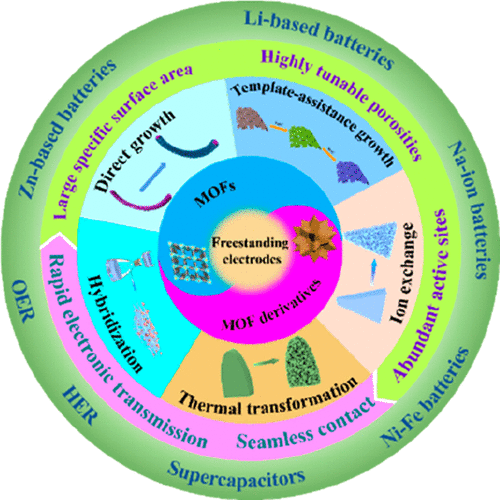当前位置:
X-MOL 学术
›
Chem. Rev.
›
论文详情
Our official English website, www.x-mol.net, welcomes your
feedback! (Note: you will need to create a separate account there.)
Freestanding Metal–Organic Frameworks and Their Derivatives: An Emerging Platform for Electrochemical Energy Storage and Conversion
Chemical Reviews ( IF 51.4 ) Pub Date : 2022-04-21 , DOI: 10.1021/acs.chemrev.1c00978 Bing He 1 , Qichong Zhang 2, 3 , Zhenghui Pan 4 , Lei Li 5 , Chaowei Li 6 , Ying Ling 2 , Zhixun Wang 1 , Mengxiao Chen 7 , Zhe Wang 1 , Yagang Yao 8 , Qingwen Li 2 , Litao Sun 5 , John Wang 4, 9 , Lei Wei 1
Chemical Reviews ( IF 51.4 ) Pub Date : 2022-04-21 , DOI: 10.1021/acs.chemrev.1c00978 Bing He 1 , Qichong Zhang 2, 3 , Zhenghui Pan 4 , Lei Li 5 , Chaowei Li 6 , Ying Ling 2 , Zhixun Wang 1 , Mengxiao Chen 7 , Zhe Wang 1 , Yagang Yao 8 , Qingwen Li 2 , Litao Sun 5 , John Wang 4, 9 , Lei Wei 1
Affiliation

|
Metal–organic frameworks (MOFs) have recently emerged as ideal electrode materials and precursors for electrochemical energy storage and conversion (EESC) owing to their large specific surface areas, highly tunable porosities, abundant active sites, and diversified choices of metal nodes and organic linkers. Both MOF-based and MOF-derived materials in powder form have been widely investigated in relation to their synthesis methods, structure and morphology controls, and performance advantages in targeted applications. However, to engage them for energy applications, both binders and additives would be required to form postprocessed electrodes, fundamentally eliminating some of the active sites and thus degrading the superior effects of the MOF-based/derived materials. The advancement of freestanding electrodes provides a new promising platform for MOF-based/derived materials in EESC thanks to their apparent merits, including fast electron/charge transmission and seamless contact between active materials and current collectors. Benefiting from the synergistic effect of freestanding structures and MOF-based/derived materials, outstanding electrochemical performance in EESC can be achieved, stimulating the increasing enthusiasm in recent years. This review provides a timely and comprehensive overview on the structural features and fabrication techniques of freestanding MOF-based/derived electrodes. Then, the latest advances in freestanding MOF-based/derived electrodes are summarized from electrochemical energy storage devices to electrocatalysis. Finally, insights into the currently faced challenges and further perspectives on these feasible solutions of freestanding MOF-based/derived electrodes for EESC are discussed, aiming at providing a new set of guidance to promote their further development in scale-up production and commercial applications.
中文翻译:

独立式金属有机框架及其衍生物:电化学能量存储和转换的新兴平台
金属-有机框架(MOFs)由于其大的比表面积、高度可调的孔隙率、丰富的活性位点以及金属节点和有机连接体的多样化选择,最近成为电化学能量存储和转换(EESC)的理想电极材料和前驱体。 . 粉末形式的 MOF 基和 MOF 衍生材料的合成方法、结构和形态控制以及在目标应用中的性能优势都得到了广泛的研究。然而,为了将它们用于能源应用,需要粘合剂和添加剂来形成后处理电极,从根本上消除一些活性位点,从而降低 MOF 基/衍生材料的优越效果。由于其明显的优点,包括快速电子/电荷传输以及活性材料和集电器之间的无缝接触,独立式电极的进步为 EESC 中基于 MOF 的/衍生材料提供了一个新的有前景的平台。受益于独立结构和 MOF 基/衍生材料的协同效应,可以在 EESC 中实现出色的电化学性能,激发了近年来越来越高的热情。本综述及时全面地概述了独立式 MOF 基/衍生电极的结构特征和制造技术。然后,从电化学储能装置到电催化,总结了独立式 MOF 基/衍生电极的最新进展。最后,
更新日期:2022-04-21
中文翻译:

独立式金属有机框架及其衍生物:电化学能量存储和转换的新兴平台
金属-有机框架(MOFs)由于其大的比表面积、高度可调的孔隙率、丰富的活性位点以及金属节点和有机连接体的多样化选择,最近成为电化学能量存储和转换(EESC)的理想电极材料和前驱体。 . 粉末形式的 MOF 基和 MOF 衍生材料的合成方法、结构和形态控制以及在目标应用中的性能优势都得到了广泛的研究。然而,为了将它们用于能源应用,需要粘合剂和添加剂来形成后处理电极,从根本上消除一些活性位点,从而降低 MOF 基/衍生材料的优越效果。由于其明显的优点,包括快速电子/电荷传输以及活性材料和集电器之间的无缝接触,独立式电极的进步为 EESC 中基于 MOF 的/衍生材料提供了一个新的有前景的平台。受益于独立结构和 MOF 基/衍生材料的协同效应,可以在 EESC 中实现出色的电化学性能,激发了近年来越来越高的热情。本综述及时全面地概述了独立式 MOF 基/衍生电极的结构特征和制造技术。然后,从电化学储能装置到电催化,总结了独立式 MOF 基/衍生电极的最新进展。最后,









































 京公网安备 11010802027423号
京公网安备 11010802027423号